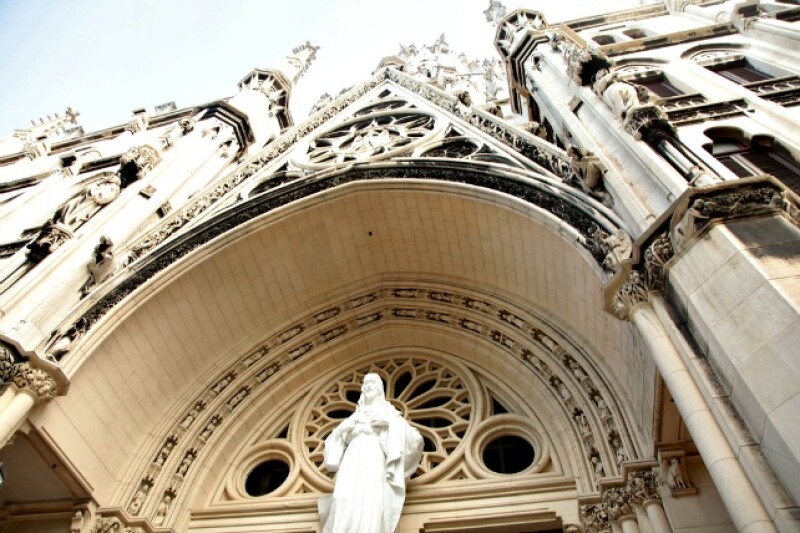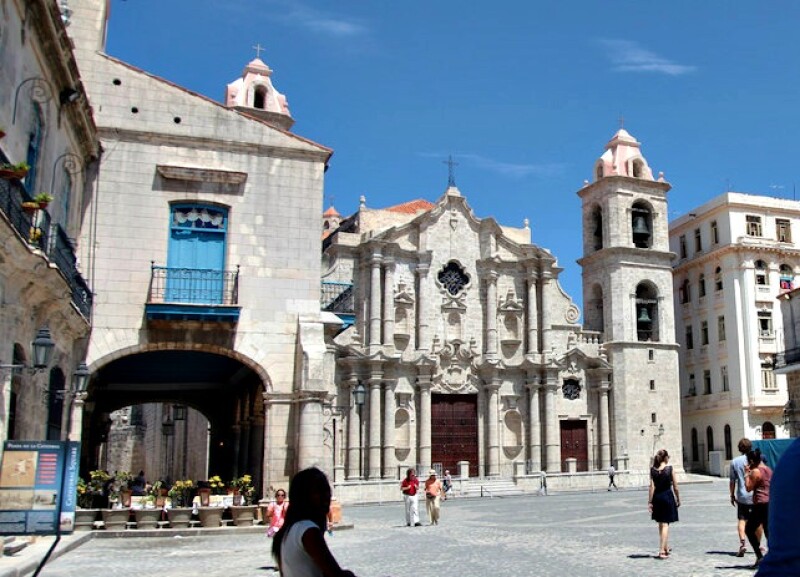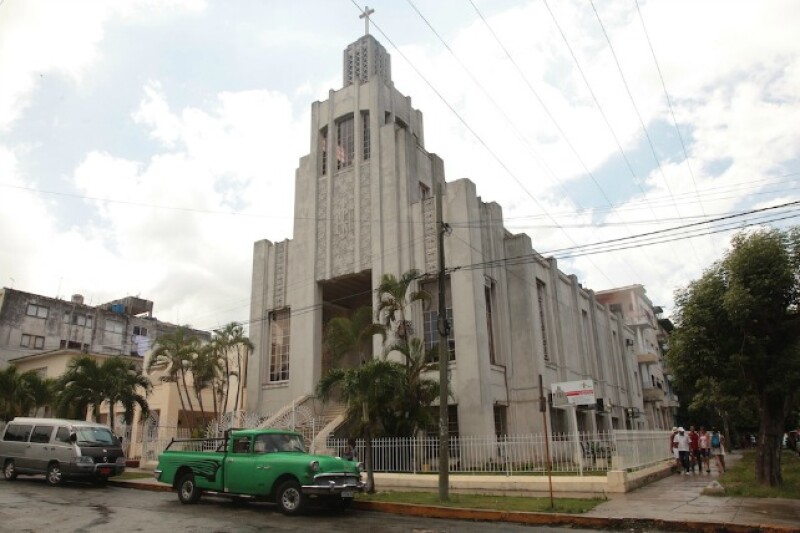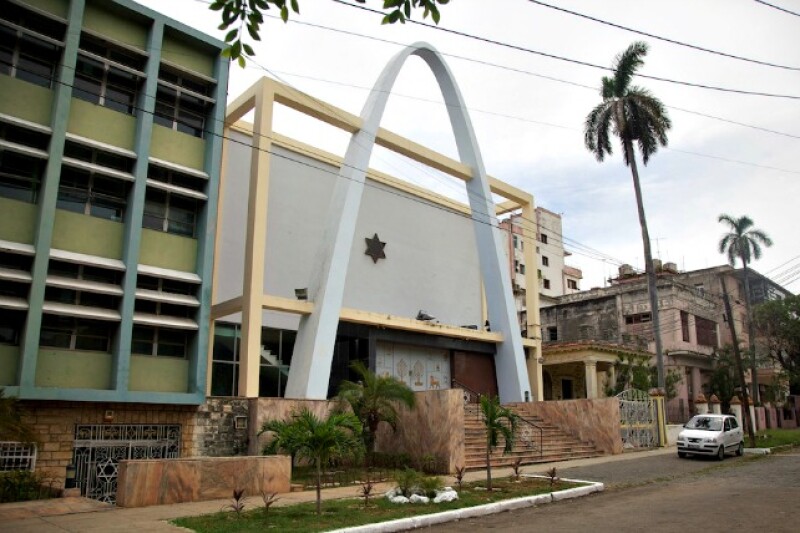I’ve traveled to the Cuban capital, Havana, more than a dozen times in as many years, but it wasn’t until I returned in September to report on the visit of Pope Francis that I paid much attention to Habaneros’ religious lives and the places where they gather to pray. Suddenly, churches and other houses of worship seemed to be everywhere. (They’d always been there, of course; I’d just never really noticed). Cuba is often viewed by those who don’t know much about it as an agnostic state. But visiting numerous churches and talking to Catholic, Jewish, and Muslim residents of Havana made me realize this is incorrect. Here are 10 of the sites of worship I visited on my most recent trip to the Cuban capital.
1. The National Library of Cuba [header photo]
It was, perhaps, the strangest sight I’d ever seen in Cuba: a larger-than-life picture of Jesus, with his left hand placed lightly over his heart, his right hand raised, his head encircled by a corona of celestial light, and, at his feet, a simple phrase: Come to me. In any other Latin American country, it wouldn’t be strange. In Cuba, however, imagery of Jesus isn’t exactly common. And yet, here he was, looking down benevolently on the crowd that would gather to hear the papal Mass. Thousands celebrated the pope’s visit and took communion in the shadow of this strangely placed Jesus.
2. Bicitaxis

Announcements of the pope’s arrival and messages welcoming him were everywhere—even on the capital’s bicitaxis.
Pope Francis was the third pope to visit Cuba; he was preceded by Pope John Paul II in 1998 and Pope Benedict XVI in 2012. Catholics I spoke with said it was Pope John Paul II’s visit that heralded a renewed sense of religious freedom on the island (though the Cuban constitution guarantees religious liberty in principle), and they fully expected Pope Francis’s visit to have even greater implications, his message reverberating beyond the island’s Catholic community to impact all Cubans.
Among the thousands who showed up for the papal mass in September were many Cubans who did not identify as Catholic or consider themselves religious at all. As one man said to me, “He came to bless everyone, right? And so even if I’m not Catholic, that means he came to bless me, too. He is the pope of the poor.”
3. Sagrado Corazón

Sagrado Corazón was one of the churches Pope Francis visited while he was in Havana. The church’s clergy are, like the pope, Jesuits.
Sagrado Corazón, a Catholic cathedral in Havana, received some exterior improvements in anticipation of Pope Francis’s visit. Inside, parishioners and visitors—some of whom admitted they had no religious ties at all—left messages of welcome and prayer requests for the pope, writing their wishes and petitions on a mural-sized piece of paper. The pope stopped briefly at the church to greet clergy during his Havana visit.
4. Saint Lazarus

Two women stand with a life-sized statue of Saint Lazarus on the side of the avenue where the papal motorcade passed.
Hundreds of people lined Carlos III (aka Salvador Allende), one of Havana’s main avenues, as the papal motorcade made its way from one end of the capital to the other. While many people waved Cuban flags, these two women went all out, bringing a near-life-sized statue of Saint Lazarus to stand with them while they waited to catch a glimpse of the pontiff. Saint Lazarus, San Lázaro in Spanish, is a figure whose story of being resurrected by Jesus is told in the Gospel of John. A popular saint in the Spanish-speaking Caribbean, he also has a counterpart named Babalú Ayé in the syncretic religion of Santería.
5. Havana Cathedral

Havana’s cathedral is considered one of the best representatives of baroque architecture on the island.
The Havana Cathedral is a baroque beauty, completed in 1777 after nearly 30 years of construction. Located in Old Havana, the church is a UNESCO World Heritage Site and was where Pope Francis presided over vespers during his September visit. The cathedral, which sits on the edge of a spacious square, often serves as a backdrop for musical and other cultural performances including, most recently, a historic concert featuring Chinese pianist Lang Lang and Cuban pianist Chucho Valdés.
6. Church of Our Lady of Charity of El Cobre

As the church named after Cuba’s patron saint, Caridad del Cobre is always busy with the faithful stopping by to say prayers.
The church of Our Lady of Charity of El Cobre opens early—7:30 a.m.—and early morning is definitely the best time to visit. While the faithful come and go all day long, the scene surrounding the church is most lively in the morning, when vendors line the sidewalks on both sides of the church, arranging and selling bouquets that will be left inside as symbols of gratitude and devotion. Visitors sit in pews or kneel to pray. They light candles and walk from one statue to another, whispering prayers. The church is a minor basilica, one of four in Cuba. These churches, so named by papal decree, possess certain special characteristics that distinguish them from a parish church; among these are the historical value and importance of the church in question, as well as the example it sets for other churches in its area.
7. First Reformed Presbyterian Church of Havana

From the outside, this Gothic church seems to wear every one of its 109 years.
Practically a neighbor to Caridad del Cobre, this church, the First Reformed Presbyterian Church of Havana, stands in marked contrast to the basilica, at least architecturally. In fact, it looks so Gothic and dingy that one would be forgiven for thinking it might be abandoned. That’s not the case, however. In addition to regular worship services, this church has an active schedule of activities that are open to the community, ranging from Bible study and English classes to tai chi sessions. The pastor of the church also founded a lending library that is open to the public, and is proud to say that every book he has ever loaned has been returned.
8. University Presbyterian Church

A diverse congregation worships at University Presbyterian Church in Havana’s Vedado neighborhood.
On the same Sunday that Pope Francis offered his mass in Havana, the congregation of University Presbyterian Church in Havana’s Vedado neighborhood gathered, as it does each week, to celebrate its weekly service. The diverse members of the church were led by a young, energetic pastor, and music figured prominently in the service, the sounds of song spilling out into the street. This church is, as its name suggests, a short walk from the University of Havana. It is also just a couple blocks away from one of Havana’s best-known hotels, the Habana Libre, which was named the Havana Hilton before Fidel Castro expelled American companies from the island.
9. Bet Shalom Synagogue

Havana’s Bet Shalom Synagogue is considered the heart of Cuba’s Jewish community.
Havana’s Bet Shalom Synagogue is the capital’s largest house of worship for Cuba’s Jews, who number around 1,500 people. It wasn’t always easy for them to observe Jewish practices and traditions during the hardest years of the Cuban Revolution, but Cuban Jews have for the most part found a safe haven and freedom from discrimination on the island. They have also been aided in upholding traditions by Jews abroad who send donations, and by laity who help perform certain rituals, such as bar and bat mitzvahs.
10. Mosque in Old Havana

Look closely: On this street in Old Havana, you’ll likely see one or more men in Islamic dress as they come and go from the capital’s new mosque.
There’s a “widespread assumption that Islam is new or foreign to [Latin America],” write the editors of Crescent over Another Horizon, a book just published about Islam in Latin America, the Caribbean, and Latino/a communities in the United States. However, Muslims have been in the Americas—Cuba included—for several centuries. Writing about Cuba’s Muslim communities, scholar Luis Mesa Delmonte explained that while the island’s Muslims existed for years without a central, shared goal of a “Muslim institution building,” Muslim observances were upheld privately, albeit, perhaps, modified amidst the customs and dominant culture of this “New World.”
These communities, once nearly invisible, especially to outsiders, are now becoming significantly more visible in Havana, particularly since the opening of a new mosque this past summer. In addition to an Arabic Union and the Casa de los Árabes, the mosque in Old Havana provides a physical location where Cuban Muslims can come together to worship and discuss the future of their community on the island.











